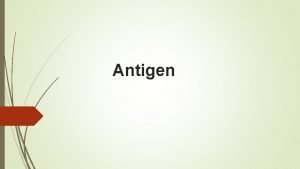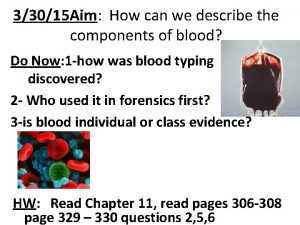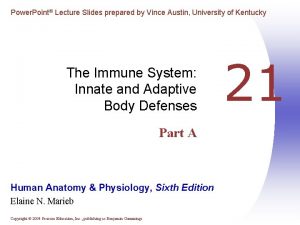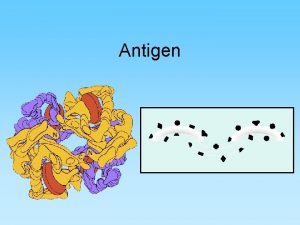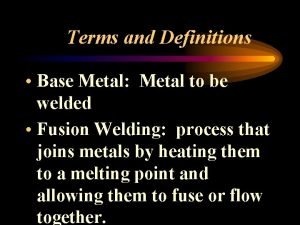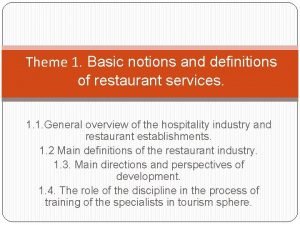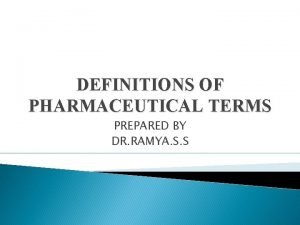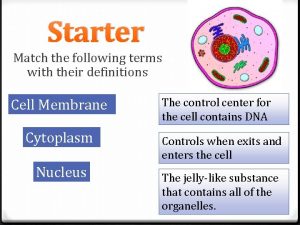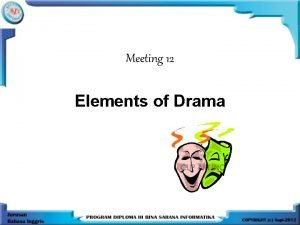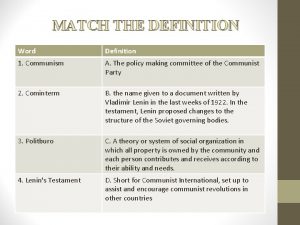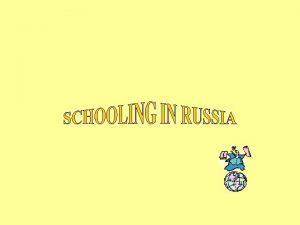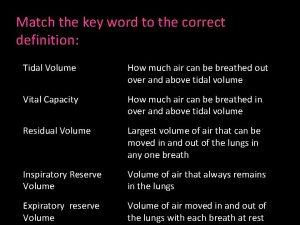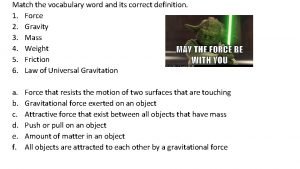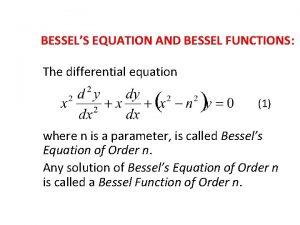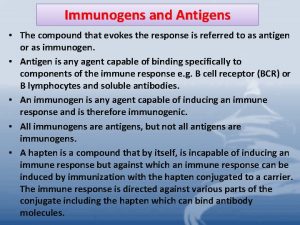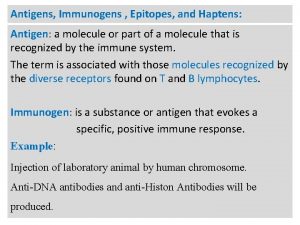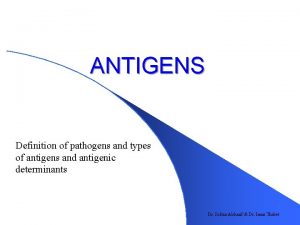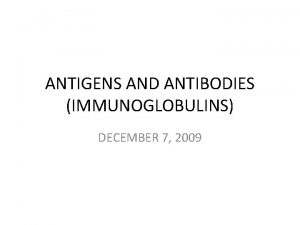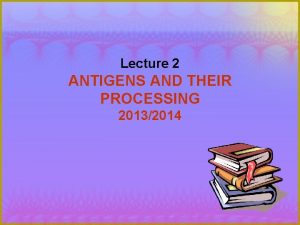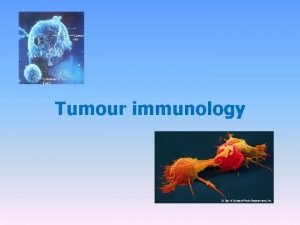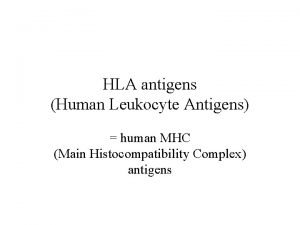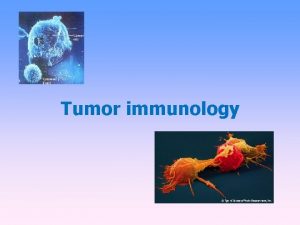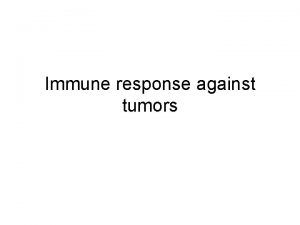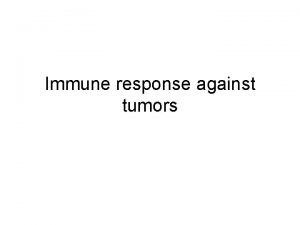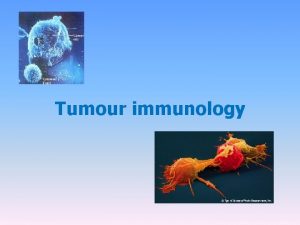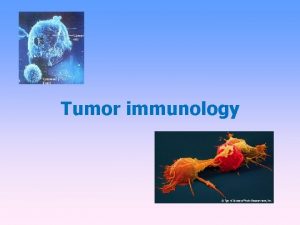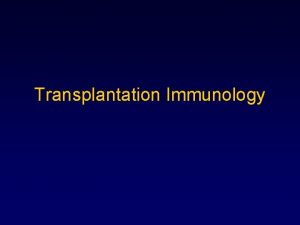Immunogens And Antigens General Terms and Definitions The

































































- Slides: 65

Immunogens And Antigens.

General Terms and Definitions • The compound that evokes the immune response is referred to as Antigen or as Immunogen. • ANTIGEN is any agent capable of binding specifically to components of the immune response e. g. B CELL receptor (BCR) or B lymphocytes and soluble antibodies. • AN IMMUNOGEN is any agent capable of inducing an immune response and is therefore immunogenic. • All immunogens are antigens, but not all antigens are immunogens.

Tolerogen • Tolerogen - an antigen that invokes a specific immune non-responsiveness due to its molecular form. If its molecular form is changed, a tolerogen can become an immunogen. Immunogenic antigen Vs. Telorgenic antigen

Allergen • Allergen - an allergen is a substance that causes the allergic reaction. the (detrimental) reaction may result after exposure via ingestion, inhalation, injection or contact with skin.

Autoantigens • An autoantigen is usually a normal protein or complex of proteins (and sometimes DNA or RNA) that is recognized by the immune system of patients suffering from a specific autoimmune disease. • These antigens should under normal conditions not be the target of the immune system, but due to mainly genetic and environmental factors the normal immunological tolerance for such an antigen has been lost in these patients.

Tumor Antigens • Tumor antigens are those antigens that are presented by the MHC I molecules on the surface of tumor cells. these antigens can sometimes be presented only by tumor cells and never by the normal ones. in this case, they are called tumor-specific antigens (TSAS) and typically result from a tumor specific mutation.

Mitogen • An agent that induces mitosis. here means to activate T cells and/or B cells without help from APCs. • Lectin, for example, concanavalin A (con. A). • LPS (lipopolysaccharide) • Staphylococcal protein A (SPA)

Antigens ØAntigen is a substance that bind specifically by antibody molecule or T cell receptor ØAntigens could be: • Microbes. • Chemical Substances ( protein, saccharides, …). • Transplanted organs or tissues. • Modified self molecules and cells. • Allergern ( pollen, dust, hair, food, dander, bee venom, drugs, …. . )

Classification Of Antigens ØAccording to Chemical Nature: 1. Proteins- virtually all 2. Polysaccharides – potentially but not always 3. Nucleic acids – poor antigens 4. Lipids- may act as haptens Ø According to Mode of Action • 1. Thymus Dependent – Protein Antigens • 2. Thymus Independent - Polysaccharides

Classification Of Antigens ØAccording to Epitope • 1. Unideterminant Univalent. • 2. Unideterminant Multivalent. • 3. Multideterminant Multivalent. ØAccording to Source • 1. Exogenous • 2. Endogenous

Classification Of Antigens ØT-independent Antigens • Complex carbohydrates • Do not require processing • Can directly interact with B cells • No memory ØT-dependent Antigens • Require macrophages or other APC • Require T-helper cells • Require major histocompatibility antigens • Mostly proteins

Classification of Antigens • Thymus-dependent Antigen(TD-Ag) • Thymus-independent Antigen(TI-Ag)

There Are Two General Classes Of Antigens: Regarding To The Source • Exogenous: presented by antigen presenting cells (APCs). these are macrophages, bcells, and some dendritic cells • Endogenous: typically peptides derived from any protein; an infected cell displays “notself” proteins and is, thus, an “altered self cell”. • exogenous: these antigens are presented in MHC-II; they are seen by T-cells with a TCR and an associated protein called CD 4. • Endogenous: these antigens are presented by MHC-I; they are seen by T-cells with a TCR and an associated protein called CD 8.

• Antibodies can recognize a various types of antigens: simple metabolites, sugars, lipids, autacoids, and hormones, as well as macromolecules such as complex carbohydrates, phospholipids, nucleic acids, and proteins. • This in contrast to T cells, which mainly recognize peptides. • However, BCR that is antibody in nature is capable for stimulation by macromolecules.

Small chemicals such as dinitrophenol, may bind to antibodies and are therfore antigens but cannot activate B cells on their own, thus they are not immunogenic. To generate antibodies specific for such small chemicals, immunologists commonly attach multiple copies of the small molecules to a protien or polysaccharides before immunization. This should leads to new term called a hapten.

Haptens • A Hapten is a compound that by itself, is incapable of inducing an immune response but against which an immune response can be induced by immunization with the hapten conjugated to a carrier. • The immune response is directed against various parts of the conjugate including the hapten which can bind antibody molecule.

Karl Landsteiner discovered Hapten, who also discovered blood group antigens and got noble prize.

Epitopes vs. Paratopes • Epitope: is the portion of an antigen that is recognized and bound by an Ab or TCR/MHC complex (aka: Antigenic Determinant). • paratope: “the site in the variable (v) domain of an antibody or T-cell receptor that binds to an epitope on an antigen.

Epitopes (Determinant Site) • The number of epitopes/molecule is the valence. • There is approximately one epitope for each increase of 10, 000 in molecular weight.

Properties of Epitope • Epitopes are actually molecular shapes that are recognized by antibody. • A protein’s epitope consist of as few as three to six amino acids. • Large immunogen may have numerous epitopes that each can trigger immune respone. • Epitopes may be repeating (identical), or they may have differing specificities.

Two Different Epitopes • B cell epitope, a portion of antigen • T cell epitope, the region of antigen molecule that is recognized by B cell molecules that are recognized by T cell receptors.

T Cell Epitope And B Cell Epitope

Requirements For Immunogenicity 1 - Foreignness • Animals normally do not respond immunologically to self. • The more foreign the substance, the more immunogenic it is. • In exceptional cases autoimmunity is formed, the immune response is directed against his or her own tissues.

Requirements For Immunogenicity 2 - High Molecular Weight • Small compounds with a m. wt. < 100 da "e. g. penicillin, aspirin, progesterone" are not immunogenic. • Compounds of m. wt. between 1000 -6000 da "e. g. insulin, ACTH" may or may not be immunogenic. • Those of M. Wt. > 6000 da "e. g. albumin" are generally immunogenic.

• The higher M. wt antigen is the more capability to elicit immune response. • Cut off value is 5000

Requirements For Immunogenicity 3 - CHEMICAL COMPLEXITY • Simple molecules such as homopolymers of amino acids "e. g. a polymer of Lysine with a m. wt. of 30, 000 da" are seldom good immunogenic. • Copolymers of several amino acids e. g. Polyglutamic, Alanine and Lysine tend to be highly immunogenic.

Requirements For Immunogenicity • Macromolecules typically contain multiple determinants, some of which may be repeated and each of which, by definition, can be bound by an antibody. • The presence of multiple identical determinants in an antigen is referred to as Polyvalency or Multivalency. • Most globular proteins do not contain multiple identical epitopes and are not polyvalent, unless they are in aggregates. • Polysaccharides and nucleic acids have many identical epitopes may be regularly spaces, and the molecules are said to be polyvalent. • Cell surfaces, including microbes, often possess polyvalent arrays of proteins or carbohydrate antigenic determinants.


A globular protein antigen usually bears a mosaic determinants ( dominant epitope clusters ) on the surface.

Major Classes Of Antigens 1 - Polysaccharides • Immunogenic when associated with protein carries. • Glycoproteins are good immunogens. • ABO blood groups which are polysaccharides on the surface of the rbcs are examples of antigenicity of polysaccharides. 2 - Lipids • Lipids are rarely immunogenic. • Lipoproteins, glycolipids are immunogenic.

3 - Nucleic Acids • They are poor immunogens. • Nucleoproteins are good immunogens. • In SLE anti-DNA antibodies are formed. 4 - PROTEINS • All proteins are immunogenic. • Complex proteins are more immunogenic because they contain multiple epitopes.

Notes: Ags should have a specific chemical nature. The most immunogenic are proteins and polypeptides Proteins < Polypeptides < Polysaccharides < glycoprotein < Glycolipids Lipids and native neucleic acids are not immunogenic

Requirements For Immunogenicity 4 - Degradability • Antigens that activate T cells to stimulate immune response must interact with MHC molecules expressed on APCS. • APCS must first degrade the antigen through antigen processing "enzymatic degradation of antigen" before they can express epitopes on their surface. • these epitopes stimulate the activation and clonal expansion of antigen-specific effector T cells. • D-amino acids are resistant to enzymatic degradation and are not immunogenic. • L- isomers are susceptible to enzymes and are immunogenic. • Carbohydrates are not processed or presented, they are unable to activate T cells, but they activate B cells.

Antigen Degradation and MHC class I presentation

Antigen Processing and MHC class II presentation

Requirements For Immunogenicity 5 - Further Requirements For Immunogenicity • The genetic makeup "genotype". • Genetic control of immune response is controlled by gene mapping within the MHC. • Allelic variation at different sites of MHC genes. • The presence of antigen-specific B and T cells.

Variability for polymorphism

Allelic variation among individuals

Requirements For Immunogenicity 6 - Dosage And Route Of Administration • Repeated administration of antigen stimulates a strong immune response. • Insufficient doses of antigen may not activate enough lymphocytes or because such a dose renders the responding cells uresponsive "TOLERANCE". • Subcutaneous administration of antigen elicit the strongest immune responses. • langerhans cells process and present antigen to effector cells.

Routes of Ag Administration Intragastri c or nasal IV IP SC The most immunogenic • I. V administered antigens are carried to the spleen where they may induce tolerance or if presented by APCs generate and immune response. • G. I. T route elicits local antibody responses within the intestinal lamina propria but often produce a systemic state of tolerance. • Administration of antigen via intranasal route "respiratory tract" often elicits allergic responses.


Antigenicity And Antigen-binding Site • Antibodies or lymphocytes usually react specifically with the antigen. • The portion of the antibody that specifically binds to the epitope is concentrated in several hypervariable regions of the molecule which form the complementarity-determining region "CDR".

Antigenicity And Antigen-binding Site • The size of the epitope that combines with the CDR on a given antibody is approximately equivalent to 5 -7 amino acids. • Epitope binds to TCR "8 -12 amino acids" is no covalently associated with MHC proteins of APC. • A trimolecular complex is formed “TCR-epitope-MHC" BCR

Antigenicity And Antigen-binding Site • The spatial arrangement of the different epitopes on a single protein molecules may influence the binding of a antibodies in several ways: 1. When determinants are well separated, two or more antibody molecules can be bound “ nonoverlapping”. 2. When two determinants are close, the binding of antibody to the first determinant may cause steric interferences with the binding of antibody to the second “ overlapping”. 3. In rare cases, binding of one antibody may cause conformational changes in the structure of the antigen, positively or negatively influencing the binding of the second antibody to another site on the surface of protein “ Steric hindrance”

Antigenicity And Antigen-binding Site • Epitopes forms by several adjacent amino acids residues are called Linear determinants. • In contrast, conformational determinants are formed by a. a residues that are not in a sequence but become spatially juxtaposed in the folded protein. • Proteins can be subjected to modifications such as glycosylation, phosphorylation, ubiquitination, acetylation, and proteolysis. Theses modification by altering the protein structure may produce new epitopes called neoantigenic determinants.



Cross Reactivity Cross reactivity:

Cross Reactivity ØToxin and Toxoid • A toxin that has been modified to loose its toxicity but retains its immunogenecity is called toxoid is used for immunization. • Toxoid cross reacts immunologically with toxin. many epitopes in the toxoid are still reactive.


Cross Reactivity • When the antigen used for immunization is different form the one with which the induced immune components are then allowed to react, the terms homologous and heterologous are used. • Homologous denotes that the antigen and the immunogen are the same. • Heterologous denotes that the substance used to induce the immune response is different from the substance that is then used to react with the products of the induced response.

ØCross reacting compounds share antigenic determinants: • Some cross-reacting substance are unrelated to each other except that they have one or more epitopes in common. • These substances are referred to as heterophile antigens. e. g. human blood group B antigen reacts with antibodies to certain strains of E. coli. The antigens of the microorganisms are referred to as heterophile antigens with respect to the blood group antigen.

Adjuvants ØThe Latin "adjuvans" means to help, particularly to reach a goal. ØAn adjuvant is a substance that when mixed with an immunogen, enhances the immune response against the immunogen. an adjuvant does not confer immunogenecity on haptens. Adjuvant Mechanisms Include: 1. Increasing the biological or immunological half-life of vaccine antigens. 2. Increasing the production of local inflammatory cytokines. 3. Improving antigen delivery and antigen processing and presentation by apcs. • Adjuvants containing microbial components e. g. mycobacterial extracts are the best adjuvants.

CLASSIFICATION OF ADJUVANT • Freund’s Adjuvant ♥ Complete Freund’s Adjuvant(CFA) ♥ Incomplete Freund’s Adjuvant(IFA) • Liposome • Inorganic Compound • Cytokine • Biodegradable Nanoparticles

An adjuvant is a substance that helps and enhances the pharmacological effect of a drug or increases the ability of an antigen to stimulate the immune system.



Superantigen • Molecules that are potent T lymphocyte mitogens and simultaneously bind to class II MHC molecules. They are often associated with Staphylococcal (SAgs )products and are involved in enterotoxemias and toxic shock syndrome in humans. • Compared to a normal antigen-induced T-cell response where 0. 001 -0. 0001% of the body’s T-cells are activated, SAgs are capable of activating up to 20% of the body’s T -cells. This causes a massive immune response that is not specific to any particular epitope on the SAg.

Superantigens • Superantigens are unusual bacterial toxins that interact with exceedingly large numbers of T 4 -lymphocytes. • Conventional antigens are engulfed by antigen presenting cells (APCs), degraded into epitopes. , bind to the peptide groove of MHC-II molecules, and are put on the surface of the APC. • Here they are recognized by specific T 4 -lymphocytes having a TCR with a corresponding shape. • Superantigens, however, bind directly to the outside of MHC-II molecules and activate large numbers of T 4 - lymphocytes.



Actions of Superantigens ØThis activation of very large numbers of T 4 -lymphocytes results in the secretion of excessive amounts of a cytokine called interleukin-2 (IL-2) as well as the activation of selfreactive T-lymphocytes. Øproduction of high levels of IL-2 can result in circulation of IL-2 in the blood leading to symptoms such as fever, nausea, vomiting, diarrhea, and malaise. • Excess stimulation of IL-2 secretion can also lead to production of other cytokines such as • Tumor Necrosis Factor-Alpha (TNF-alpha), Interleukin-1 (IL-1), Inflammatory Chemokines such as IL-8, Platelet-activating factor (PAF), can lead to the same endothelial damage, acute respiratory distress syndrome, disseminated intravascular coagulation, shock, and multiple organ system failure seen with endotoxin. Øactivation of self-reactive T-lymphocytes can also lead to autoimmune attack.

Examples of Superantigens 1. Toxic Shock Syndrome Toxin-1 (TSST-1), 2. Streptococcal Pyrogenic Exotoxin (SPE), produced by rare invasive strains and scarlet fever strains of streptococcus pyogenes (group A beta Streptococci). 3. Staphylococcal Enterotoxins (SE), 4. Superantigens Associated With Streptococcus Pyogenes are also thought to be responsible for psoriasis. 5. Antigens associated with Mycobacterium Tuberculosis, the rabies virus, and possibly HIV may also function as superantigens.

Other Antigens ØHeterophilic Antigen : a kind of common antigen, existing in human, animals, and microbes. Fossman antigen. ØXenogenic Antigen: this antigen comes from different genus and generic. for example, pathogenic antigen. ØAllogenic antigen: the specific antigen exists in different individuals. blood type antigens ØIdiotypic antigen: an antibody molecule is some sort of foreign molecule when generated in animal body. such that immune system recognizes it as antigen, which is known as Idiotypic antigen.

 Thymus independent antigens
Thymus independent antigens Thymus independent antigens
Thymus independent antigens Lattice formation antigen antibody reaction
Lattice formation antigen antibody reaction Blood types chart
Blood types chart Complete antigens
Complete antigens Antigen vs superantigen
Antigen vs superantigen The correct shutoff procedure for an oxyacetylene torch is:
The correct shutoff procedure for an oxyacetylene torch is: Framing terms and definitions
Framing terms and definitions What is collinear
What is collinear Restaurant terms and definitions
Restaurant terms and definitions Undefined terms and basic definitions worksheet answers
Undefined terms and basic definitions worksheet answers Pharmacopollaxy
Pharmacopollaxy Match the following terms with their definitions.
Match the following terms with their definitions. What is the role of drama in society
What is the role of drama in society Match the following terms with their definitions communism
Match the following terms with their definitions communism Match the words with the correct definitions.
Match the words with the correct definitions. Match the terms below with their correct definitions
Match the terms below with their correct definitions What is the correct definition of force?
What is the correct definition of force? Polynomial degrees and terms
Polynomial degrees and terms What are like terms
What are like terms General and specific words
General and specific words Find a general solution in terms of bessel functions
Find a general solution in terms of bessel functions Hát kết hợp bộ gõ cơ thể
Hát kết hợp bộ gõ cơ thể Lp html
Lp html Bổ thể
Bổ thể Tỉ lệ cơ thể trẻ em
Tỉ lệ cơ thể trẻ em Chó sói
Chó sói Glasgow thang điểm
Glasgow thang điểm Hát lên người ơi
Hát lên người ơi Các môn thể thao bắt đầu bằng tiếng đua
Các môn thể thao bắt đầu bằng tiếng đua Thế nào là hệ số cao nhất
Thế nào là hệ số cao nhất Các châu lục và đại dương trên thế giới
Các châu lục và đại dương trên thế giới Công thức tính độ biến thiên đông lượng
Công thức tính độ biến thiên đông lượng Trời xanh đây là của chúng ta thể thơ
Trời xanh đây là của chúng ta thể thơ Mật thư tọa độ 5x5
Mật thư tọa độ 5x5 Phép trừ bù
Phép trừ bù Phản ứng thế ankan
Phản ứng thế ankan Các châu lục và đại dương trên thế giới
Các châu lục và đại dương trên thế giới Thể thơ truyền thống
Thể thơ truyền thống Quá trình desamine hóa có thể tạo ra
Quá trình desamine hóa có thể tạo ra Một số thể thơ truyền thống
Một số thể thơ truyền thống Cái miệng nó xinh thế
Cái miệng nó xinh thế Vẽ hình chiếu vuông góc của vật thể sau
Vẽ hình chiếu vuông góc của vật thể sau Biện pháp chống mỏi cơ
Biện pháp chống mỏi cơ đặc điểm cơ thể của người tối cổ
đặc điểm cơ thể của người tối cổ Thế nào là giọng cùng tên?
Thế nào là giọng cùng tên? Vẽ hình chiếu đứng bằng cạnh của vật thể
Vẽ hình chiếu đứng bằng cạnh của vật thể Fecboak
Fecboak Thẻ vin
Thẻ vin đại từ thay thế
đại từ thay thế điện thế nghỉ
điện thế nghỉ Tư thế ngồi viết
Tư thế ngồi viết Diễn thế sinh thái là
Diễn thế sinh thái là Các loại đột biến cấu trúc nhiễm sắc thể
Các loại đột biến cấu trúc nhiễm sắc thể Các số nguyên tố là gì
Các số nguyên tố là gì Tư thế ngồi viết
Tư thế ngồi viết Lời thề hippocrates
Lời thề hippocrates Thiếu nhi thế giới liên hoan
Thiếu nhi thế giới liên hoan ưu thế lai là gì
ưu thế lai là gì Sự nuôi và dạy con của hổ
Sự nuôi và dạy con của hổ Sự nuôi và dạy con của hươu
Sự nuôi và dạy con của hươu Hệ hô hấp
Hệ hô hấp Từ ngữ thể hiện lòng nhân hậu
Từ ngữ thể hiện lòng nhân hậu Thế nào là mạng điện lắp đặt kiểu nổi
Thế nào là mạng điện lắp đặt kiểu nổi Planos en cinematografia
Planos en cinematografia Where did general lee surrender to general grant?
Where did general lee surrender to general grant?

